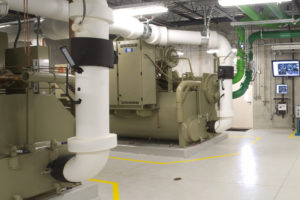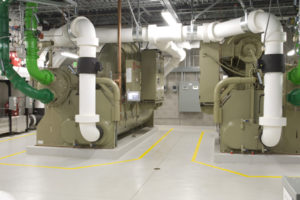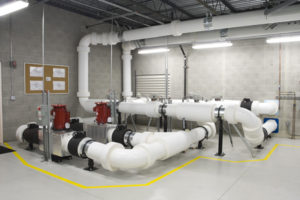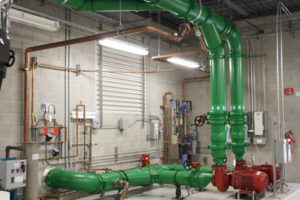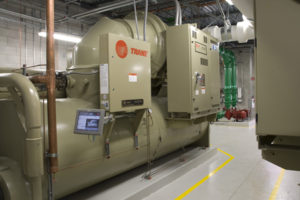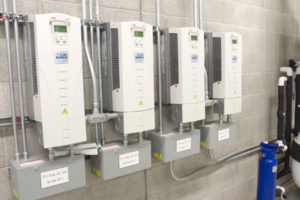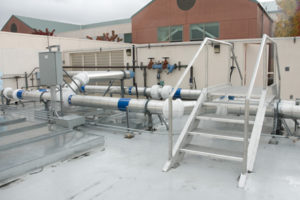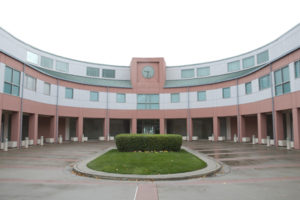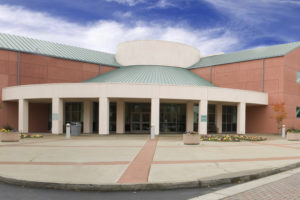CONFERENCE CENTER HVAC REDESIGN DELIVERS COOL SAVINGS
Property Address: 3301 Crow Canyon Road, San Ramon, CA 94583 Property Name: San Ramon Valley Conference Center TES* Project
The Property:
PG&E owns this state-of-the-art business and conference center, whose campus is comprised of 18 buildings. In addition to a network of meeting rooms of varying sizes, the complex includes dining and catering facilities, a fitness and recreation center and lodging.
The San Ramon Valley Conference Center is a certified green business, an important draw for environmentally-minded clientele. The green certification also means that PG&E has precision control over operating costs, as well as drastically reducing waste and pollution associated with running a conference facility of this size.
The Project:
The San Ramon Valley Conference Center is cooled by a central, on-site plant. Under the site’s original design, the plant was equipped to manufacture ice in a dedicated cooling room using ice harvesters. The ice harvesters were scheduled to run daily during off-peak hours, manufacturing ice to meet the cooling needs in each of the campus’s 18 buildings. The off-peak production schedule allows the system to perform its heaviest workload – ice production – when energy demands are low and when electricity rates are lowest. During peak hours, the system would circulate water through the ice to provide the cooling according to the demands controlled by individual thermostat settings throughout the facility.
Even with this load-shifting schedule in place, the ice manufacturing plant at the complex was a 1.4 kilowatt (kW) per ton plant. PG&E wanted to reduce the amount of power required by the plant to meet the convention center’s cooling needs. To accomplish this, PG&E issued a performance-based RFP to source an HVAC vendor who could design and build a more energy-efficient system. PG&E’s goal was to reduce the energy required by the plant from 1.4 kW per ton to .80 kW per ton.
Project Highlights
The Hurdles:
The existing plant was comprised of two ice harvesters and a 150-ton air cooled chiller. The Ice harvesters ran seven days a week to manufacture enough ice to fill an enormous tank during off-peak hours to meet the daily demands of the Center. Thus, a massive amount of energy was required to manufacture sufficient ice in a short period of time, to meet the round-the-clock cooling demands, while not firing up the harvesters during peak energy hours.
The first solution proposed was to install smaller ice tanks, which would use less energy and meet PG&E’s .80 kW per ton requirement. The tradeoff was that they couldn’t produce enough ice to meet the demands of the complex and still run only during off-peak hours.
So the hurdles that had to be overcome were: 1. The site had to have plenty of chilled water available 24 hours per day. 2. The new chiller plant could not run during peak the peak rate period. 3. It takes more energy – not less – to manufacture the amount of ice needed in a shorter period of time.
The Matrix Solution:
Matrix recognized that this was not a project where an “off-the-shelf” solution would suffice. One of Matrix’s strengths is in recognizing the limitations present in what might otherwise seem like the most obvious solution to an HVAC problem. Installing chillers out-of-the-box would not solve the problem of using less power to produce the amount of ice required in a restricted period of time.
Unlike larger HVAC companies who rely solely on staff engineers, Matrix is committed to sourcing the best engineer for each HVAC project, whether they are sourced internally or externally. For the San Ramon Valley Conference Center project, we partnered with Scot Duncan of ROI Engineering because of his specialization in Thermal Energy Storage, coupled with Scott’s “whole system” approach to mechanical system architecture.
The Matrix HG Solution called for:
- Installing a chilled water storage system, reusing the existing ice tank.
- Replacing 23 chilled water coils to High Delta T coils, which increased capacity and over efficiency of the system.
- Preventing any disruption in service to the complex during construction by:
- Creating 100% redundancy to the existing system
- Performing all work after business hours
- Setting up a rental chiller and tying it into the building’s existing cooling system
- Connecting the temporary chiller to the existing DDC (digital direct control) system so that it would start and stop automatically, just like the existing unit.
- Fully designing and installing a new chiller plant in a brand new building, designing every component for maximum efficiency, incorporating:
- Two 500-ton centrifugal chillers with variable frequency drives (VFD’s)
- Two variable speed cooling towers
- 6 variable speed pumps
- A custom header in the chilled water storage tank (over 1000 ft of piping)
- Eight VFDs (variable frequency drives)
Results:
- Completed in October 2009, the entire HVAC replacement project was completed with no disruption of the San Ramon Convention Center’s cooling systems.
- The energy usage of the new plant is .63 kW per ton – less than one-half of the original rate, and significantly surpassing the client’s goal of .80 kW per ton.
- The system currently operates at .60 kW per ton – and that rate continues to drop.
- Following completion, Matrix HG and ROI-Engineering commissioned and trained staff to properly maintain the new cooling plant.
- The project was completed with 6,500 injury-free man-hours.
- Matrix HG not only reduced the cost of electricity for the facility by an impressive 17%, the Matrix solution also cut the Center’s natural gas usage by 20%.
*Thermal energy storage

